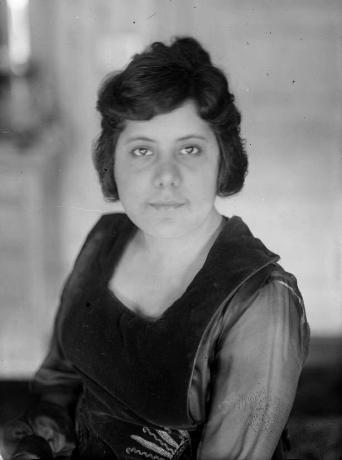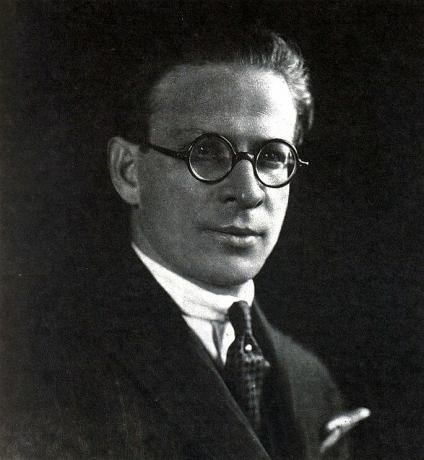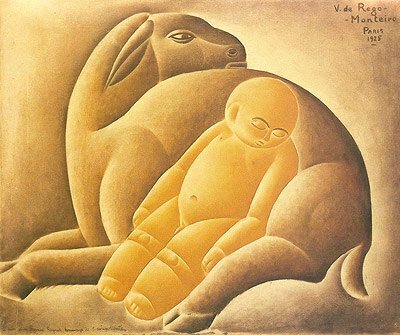The Modern Art Week was an event of great importance that took place in February 1922 at the Municipal Theater of São Paulo.
The artists who participated in the Semana de 22, as it became known, were young idealists and visionaries who were looking for a renewal of arts and culture on Brazilian soil.
Thus, they were inspired by European avant-gardes - innovative artistic currents of the early 20th century - to build a daring aesthetic that addressed national issues.
Several personalities were present at the event, from different artistic languages such as painting, sculpture, music and literature.
1. Anita Malfatti (1889-1964)
The painter, draughtsman and teacher Anita Malfatti was perhaps the most important woman to participate in the Modern Art Week.

Between 1910 and 1914, Anita studied in Germany and there she came into contact with avant-garde trends, such as expressionism, which is strongly manifested in her work.
Presenting a painting aligned with European modernism, it had already caused controversy in 1917 when hold an exhibition, which was heavily criticized, mainly by the writer Monteiro Lobato (1882-1948).
Thus, in 1922 he participated in the Semana with around 20 canvases, among them the fool (1916). The painting brings many characteristics of modernism, with marked colors, irreverence, deformities, rejection of academicism and realistic figures.

After the Semana de 22, Anita Malfatti continued to produce some paintings with modern elements, but left aside the ruptures and daring, relying on Fauvism and naive art.
To learn more, read: Anita Malfatti: biography, works and exhibitions
2. Di Cavalcanti (1897-1976)
Emiliano Augusto Cavalcanti de Albuquerque e Melo, or simply Di Cavalcanti, was one of the creators of the Modern Art Week.

A designer, caricaturist, painter and writer, he created the poster and catalog for the event. In addition, he exhibited more than 10 works on the occasion.
He sought through his work the appreciation of Brazilian culture, bringing regional themes, such as popular festivals and the people.

One of the great influences for Di Cavalcanti was the Cubist painter Pablo Picasso, in addition to the Mexican muralism of Diego Rivera.
3. Mario de Andrade (1893-1945)
The intellectual Mario de Andrade was, in addition to being a writer, an art critic, a photographer and a researcher of music and folklore.

He developed an intense work of valuing national identity and diversity, becoming one of the exponents of culture in the country.
His performance in the Week of 22 was very significant, being one of the main organizers of the event.
It was also in that year that he launched Paulicéia Desvairada, a landmark for the modernist movement, inaugurating its first phase.

The book presents poems that boldly display the effervescence and tension in the São Paulo metropolis at the beginning of the 20th century.
4. Oswald de Andrade (1890-1954)
Another great organizer of the Semana de 22 was the writer and cultural agitator Oswald de Andrade.

Coming from a wealthy family, Oswald spent some time in Europe and got to know some trends in modern art that was at its peak.
Upon returning to Brazil, he feels the need to put some of these European influences into practice, but seeking to address national issues and themes.
So, he organizes himself with friends and thinks of a way to show this new aesthetic, creating the Modern Art Week.
Later, he marries Tarsila do Amaral (1886-1973). The important painter was not present at the Semana de 22, but was an essential name for the implementation of modernism in Brazil.
Together, they created the Movimento Antropofágico, whose objective was the valorization of Brazilian culture and was very relevant in the first phase of national modernism.
5. Victor Brecheret (1894-1955)
When talking about modern sculpture in Brazilian art, a name that stands out is that of Italian-Brazilian Victor Brecheret.
Brecheret also had part of his artistic training in Europe, which directly influenced his work.
The simplicity of forms and the appreciation of expressiveness are characteristics of his sculptures.

Thus, in 1922 the artist was also among the modernists who performed at the Semana, exhibiting 12 pieces at the Theatro de São Paulo.
6. Villa-Lobos (1887-1959)
The multi-instrumentalist and conductor Heitor Villa-Lobos was one of the Brazilian artists who had an enormous importance in the modernist context, at the beginning of the 20th century, leaving a precious legacy.

She participated in the Semana de 22 playing in the three days of the event, as her music gathered the characteristics essentials of modernism, combining classical and popular music, resulting in a bold and transformer.
There are many songs that stand out from her, such as the series of compositions entitled Bachianas Brasileiras, produced from the 1930s onwards.
7. Guiomar Novaes (1895-1979)
There were few women present at the Semana de 22, but in the field of music, pianist Guiomar Novaes deserves to be highlighted.

A precocious artist, Novaes began his studies on the piano as a child and trained in France. In the 20's she comes to Brazil and in 1922 she participates in the Semana playing Chopin songs.
Guiomar Novaes consolidates his career internationally, taking the work of his colleague Villa-Lobos to other countries.
8. Menotti Del Picchia (1892-1988)
Menotti Del Picchia was one of the organizers of the Modern Art Week.
Writer, politician, lawyer and painter, Menotti had an important role in the event, opening the second night, the most controversial.

With Tarsila do Amaral, Anita Malfatti, Mário de Andrade and Oswald de Andrade, he formed the Grupo dos Cinco, which defended the modernist ideology proposed in the Semana.
However, contradictorily, he later joined Plínio Salgado (1895-1988), Guilherme de Almeida (1890-1969) and Cassiano Ricardo (1895-1974) and idealizes the Movimento Verde-Amarelo, which was opposed to the anthropophagic values of Tarsila and Oswald, thus founding a nationalist current with a bias fascist.
9. Vicente do Rego Monteiro (1899-1970)
The painting show at the Modern Art Week also featured works by the young artist from Pernambuco, Vicente do Rego Monteiro.
The painter, who was 23 years old at the time, already had a mature production, bringing many influences from the European avant-gardes. That's because she had studied arts in Paris in her early youth, coming into direct contact with the innovations that emerged there.

One of the trends that appears on her screens is Cubism. Her paintings are marked by geometric shapes and simplifications, displaying the figures in an almost sculptural way.
10. Zina Aita (1900-1967)
Teresa Aita, known as Zina Aita, is an artist little remembered today, but she was one of the forerunners of modern art, especially in Minas Gerais, her state of origin,
She also studied in Europe, like most modern artists. When she returns to Brazil, she gets closer to the modernist group, becoming friends with Anita Malfatti and Mario de Andrade.
His work, composed of paintings, ceramics and drawings, integrates elements of post-impressionism and art nouveau.

Two years after the Semana, Aita moves to Italy, where her ceramic pieces are successful and she is recognized.
11. Manuel Bandeira (1886-1968)
Manuel Bandeira is one of the most renowned writers of the first modernist generation. Known mainly for his poetry, Bandeira was also a chronicler, translator and teacher.

In 1917 he published his first book, the ash of the hours, which brings together poems where some aspects of modernist aesthetics already appear.
Later he met Oswald de Andrade and got involved in discussions about the new art forms present in the European avant-gardes.
Thus, he participates in the Semana de 22 with the poem the frogs, recited by Ronald de Carvalho. The presentation was booed, as the public did not understand and did not accept the text, full of criticism of conservatism.
Recurring themes in his production are everyday situations, melancholy and childhood, displayed in free verse and informal writing.
maybe you are interested:
- Modern Art Week
- Modern Art
- european vanguards
- Modernism
- Modernism in Brazil
